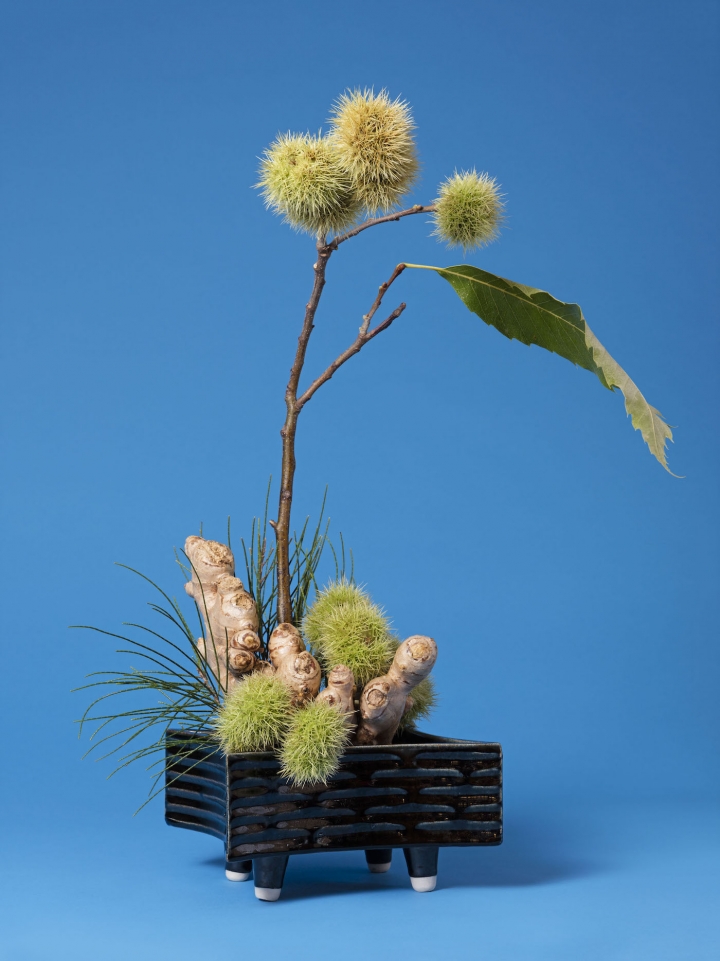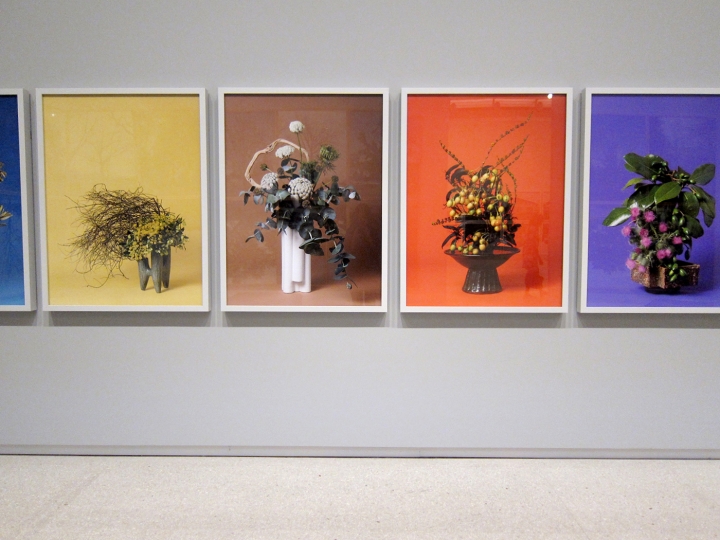Bouquets Highlight Plants Used to Control Women’s Reproductive Health
An exhibition looks at plant remedies that women have used to control their reproductive lives.
by Claire Voon
April 10, 2017

Ann Shelton, “The Vixen, Ginger (Zingiber sp.),” from jane says (2015-ongoing)
AUCKLAND, New Zealand — Delicate and dainty, Queen Anne’s Lace is a popular pick for wedding bouquets — but the white flower also has a long history as a naturally occurring contraceptive. The alleged power of its seeds, when chewed and ingested, to prevent pregnancy after sex, are recorded in ancient writings by Hippocrates to Pliny the Elder to physicians like Pedanius Dioscorides and Scribonius Largus, as historian John M. Riddle chronicles in his book on herbal abortifacients, Eve’s Herbs: A History of Contraception and Abortion in the West. Yet, to turn to these oil-filled pips — or to many of these natural remedies — is to take a risk, as they are, to this day, experimental treatments.
The complicated, at times ugly, histories of plants used in the West for both birth control and increased fertility is revisited with unexpected beauty and simplicity in jane says, an ongoing series by New Zealand photographer Ann Shelton. Drawing largely from Riddle’s tome, Shelton selected about a dozen living specimens, arranged each one in separate vases in the style of Japanese ikebana (with other plants), and photographed the sculptural bouquets against an array of colorful backdrops.
The resulting prints are currently on view at Auckland Art Gallery Toi o Tāmaki as part of Shelton’s retrospective, Dark Matter. Curated by Zara Stanhope, the exhibition centers on series that explore themes from trauma to female authorship through photos that often conflate fact and fiction. jane says is one of the most startling works, seemingly innocuous at first glance, like Taryn Simon’s similarly vivid replicas of floral arrangements at diplomacy talks. Enlarged, Shelton’s photographs hang as monuments to narratives largely forgotten, overlooked, or excluded from the canon of Western medicine. Most people are unlikely to look at a cluster of ginger, quirkily tucked in a low pot, for instance, and immediately think, “period inducer!”
The series doesn’t take a hard and clear stance on abortions rights, but it highlights nagging issues of control at the root of these herbal regimes. Shelton’s reference to ikebana, which she learned over a few months, is fitting, with the rigid and purposeful intertwining of stems, twigs, and buds serving as a poetic metaphor for the unseen agencies over human bodies these plants purportedly assert — an extension of the control women have taken over their own livelihoods. However, the striking images beg the question of why women turned to these herbal treatments. Did they attempt these remedies because they had freedom to choose, or were these their only options? Control, of course, is also exercised through the suppression of freedoms.

Installation view of Dark Matter at Auckland Art Gallery Toi o Tāmaki (photo by the author for Hyperallergic)
Shelton herself is asserting control within the discourse of contraception, which men have long dominated — as evidenced by the aforementioned ancient thinkers — and still do. Literally taking these plants into her own hands, she first sources them from sites near her home before carefully arranging them to photograph. The process for each could take days, involving careful nurture of the plants. The final, highly constructed images are the product of female authorship, of determined management of unregulated specimens that may serve as a woman’s only solution. Photographed at the peak of life, the bouquets embody both the enhanced fertility some seek, but
they also allude to desired termination — the gathered flora all eventually withered and are now long dead.
Bodies are absent in jane says, with Shelton instead relying on language to address the power dynamics surrounding the culture of abortifacients. Its title arrives from the 1988 song by Jane’s Addiction, which addresses problematic, haunting drug use. But “jane says“ more simply presents the series as an amplifier of women’s voices, with “Jane” serving as a placeholder name for those anonymous individuals who grapple with issues of conception. The two words equate to a demand, suggestive of women who claim the right of ownership of their bodies no matter their diverse stories.
The titles of the individual photographs not so subtly showcase the menacing responses to this seizing of charge. Bestowed names such as “The Vixen,” “The Hysteric,” “The Comfort Woman,” and “The Courtesan,” they remind of the variety of stigmas through history often attached to women who seek both fertility treatments and birth control. Following each diminutive is the featured plant’s more sterile, Latin name. Reading this combination of fiction and fact transforms each arrangement into an organism with personality, photographed as if for a studio portrait. Shelton leaves us with the choice to either sympathize or condemn.
The images themselves don’t offer clues to each plant’s specific medicinal powers, but visitors can take away a poster filled with quotations about abortifacients Shelton collected over the course of her research. Besides Riddle, she also consulted literature by women, including Margaret Sparrow, a leading advocate of women’s reproductive rights in New Zealand; by historian Londa Schiebinger; and by herbalist Susun S. Weed. Their writings reveal how Quinault Indians consumed an infusion of pompom-like thistles, captured in Shelton’s photo, “The Child Bride,” to induce temporary sterility; how Māori would boil the leaves of native poroporo, featured in “The Courtesan,” and drink the broth as a contraceptive. Some quotes touch upon plants Shelton has not photographed, like the peacock flower (flos pavonis), whose seeds African slaves and Indians in Dutch-colonized Surinam once used to prevent pregnancy. Many of these sentences were spoken by two women during an accompanying performance, “The physical garden,” which was enacted a number of times throughout the exhibition’s run.
Although Shelton’s research is based on historic usages of these plants, her arrangements are uprooted from the past and presented as contemporary, living bouquets. It’s impossible to view them and not consider the discourse around these treatments in today’s age, particularly those that may be used as contraceptives. Women around the world continue to fight for control over of their reproductive rights: in New Zealand, abortion remains criminalized by law, which sets aside an exception for the procedure if approved by two certified consultants; for those of us in the United States, we’re witnessing threats to essential health service organizations like Planned Parenthood. Meanwhile, interest in herbal alternatives to terminating pregnancy is currently on the rise, facilitated by online guides such as Sister Zeus, which features instructions on using herbs as emmenagogues or fertility boosters (along with plenty of disclaimers). The question of the past lingers, but with a telling tack-on: why are women resorting to long-debated means of abortion, when we now have scientifically approved, modern medical solutions?
As Shelton learned firsthand, acquiring these plants isn’t exactly easy. Her arrangements are limited to the plants she could find in her home region; at times, she used a stand-in specimen from the same botanic family. Of course, the internet eases our ability to procure these herbs. But jane says raises pertinent concerns about limits to access. Making a selection of these ancient plant remedies visible today, the series reminds that laws that limit abortion do not eliminate the need for one and instead make the procedure more dangerous. Mesmerizing to behold, the elegant floral works are like artworks in multi-hued vacuums, and they subtly send the same warning message: look, but don’t touch.

Installation view of Dark Matter at Auckland Art Gallery (photo by the author for Hyperallergic)
Dark Matter continues at Auckland Art Gallery Toi o Tāmaki (Corner Kitchener and Wellesley Streets, Auckland, New Zealand) through April 17.
